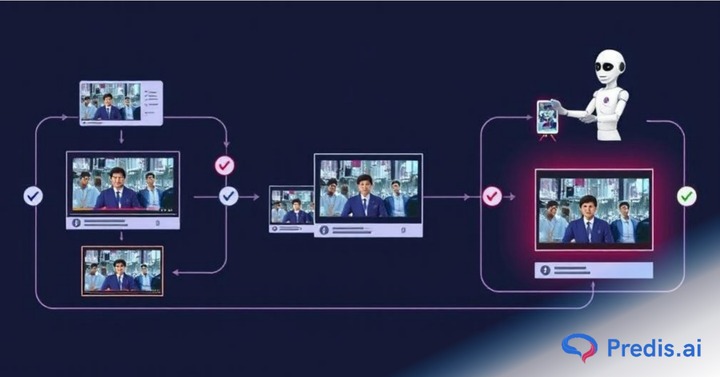Traditionally, making a video meant spending hours of your time and even more money to get the output right. But ever since AI came into the picture, the script has been flipped on its head. Now, making videos is the easiest thing you can do, because all you have to do is write a prompt, and AI will do the rest. As a result, you get to churn out videos much faster than ever before. This here where companies face a challenge. Their systems cannot keep up with the speed at which AI creates content. With so many versions to review and approvals to get, the AI video workflow process truly becomes a nightmare.
This is what we aim to straighten out in this blog, by helping you set up a versioning and approval process that can help you maintain the quality of your videos consistently. So, let’s dive in!
What are Versioning and Approval workflows, and why are they important?
Imagine you have a video draft that was generated by AI, and you send it to your stakeholders for approval. You have multiple stakeholders, so you are getting revisions from all sides. So, you get the AI to make these changes.
But then revisions pile up, and you lose track of which version you are working on and which change was provided by which team member. In short, you have a mini disaster at hand. And at last, you either give up the whole AI video workflow and start from scratch or muddle up the confusion even more.
This is where versioning and approval workflows can help you keep things straight. With versioning, you will have a clear idea of who requested what change, what the final draft and why each change was made. With approval workflows, all the key stakeholders will be aware of the changes that are happening with the final output.
Points to keep in mind when establishing a AI video versioning workflow
Now that we have established that versioning is an important part of maintaining quality, let us see some pointers that can help you create one successfully:
- Have a version control policy – This outlines everything from naming to documenting and getting approval of each version.
- Assign roles accordingly – Set up a team and assign roles accordingly to each team member as content creator, reviewer, approver, and compliance officers to ensure accountability. This way, everyone understands their roles and responsibilities.
- Set up a review process – Now that you have a policy and people to put it in place, the next thing to tackle is the actual process. Before you finalize an iteration, make sure the content follows through with the brand guidelines and compliance requirements. By establishing a review process, this can be streamlined.
- Maintain clear documentation – For every iteration, keep detailed documentation on who requested the change, why, and how it was implemented. This will ensure accountability and transparency.
- Update the team regularly – Every time a change happens, inform the team and ensure they can access the current version. With this, you can keep the team in the loop of what is going on.
- Assess the workflow – Keep track of how the versioning process proceeds and make changes accordingly so that it flows like clockwork.
Challenges teams face when scaling AI videos
Although having the ability to make videos quicker and more efficiently is a game-changer, it does not mean it comes with no challenges. Some of the issues that teams face when they scale AI videos include:
- Maintaining visual style and tone throughout all the versions of the video. Sometimes AI deviates from the style used in the previous version.
- Feedbacks are generally scattered and comes from different stakeholders, which makes it hard to keep track of it.
- When more stakeholders are present, it makes collaboration hard. Keeping everyone in the loop is also a major trouble.
- Tracking multiple drafts and versions can be overwhelming, with team members not being on the same page.
All these reasons are why many companies prefer to have automated, centralized AI video workflow that will take care of all this confusion for them.
How can Predis AI assist you in this dilemma?
Having a tool to make your AI videos and another to just take care of your versioning and approval workflows will add to your mental load. This is why having a tool that can do it all is essential. One such tool that can get this done is Predis AI. Let us take a brief look at how Predis AI does just that:
- For those who don’t know, Predis AI can make social media, e-commerce, product, and even AI avatar videos from scratch with just a simple prompt.
- You can duplicate projects easily and create different versions of the same video. You get to keep a clean record of the videos and have clear version clarity since all the variations are stored in one place.
- Get approvals from your team members and make sure that the video goes live only after the approval is processed.
By adding simple, additional steps in your content creation process, you can make versioning and approval workflow a seamless task.
Building Multi-Layer Approval Workflows for AI Videos
To scale video content effectively, you need a workflow that moves through multiple layers of approval. This process ensures that every part of the video—script, visuals, voiceover, messaging, and formatting—receives the right oversight.
A typical multi-level workflow might include:
- Initial AI-generated draft
- Script review
- Visual and design review
- Compliance or legal review
- Final publishing approval
Each stage has a clear owner, ensuring no steps are skipped and no responsibilities overlap. This structure keeps teams aligned and reduces confusion.
Predis supports these workflows by centralizing access. Instead of sending files back and forth, stakeholders can open the same project, leave comments, tag team members, request changes, and review updated versions—all within the platform. This eliminates the bottleneck of scattered communication.
With clear checkpoints built into your process, approvals flow naturally from one stakeholder to the next. Everyone knows what stage they’re in, what comes next, and what needs attention.
Creating Documentation for Smooth Internal Collaboration
As your video creation pipeline grows, documentation becomes essential. This can include style guides, versioning rules, workflow diagrams, and review guidelines. Documentation ensures that new team members or external collaborators onboard faster and understand how the process works.
Good documentation should answer questions like:
- How should videos be named or tagged?
- Who approves scripts?
- What visuals are allowed or restricted?
- What constitutes brand-safe messaging?
- What is the expected turnaround time for approvals?
When everyone understands the rules, workflows remain smooth even when teams scale or change.

Final Thoughts
Scaling AI-generated videos is no longer about producing content quickly—it’s about managing that content efficiently. Versioning, structured approval workflows, and centralized feedback systems make it possible to maintain quality without slowing down production.
Predis AI brings all these elements together, enabling teams to scale their video output confidently while staying organized, aligned, and in control. With the right structure in place, AI video production becomes not just fast but consistently high quality. So, sign up today and begin your journey!
FAQ:
By implementing versioning in your workflow, you get to keep track of changes, what it was built on the previous version, and who gave the feedback. By keeping track of these content changes, you know what the final version is and why each change was made.
Yes, by having a structured approval process, you can keep up with the speed at which AI creates videos. This way, you can get content published more quickly without confusion and ambiguity.
















